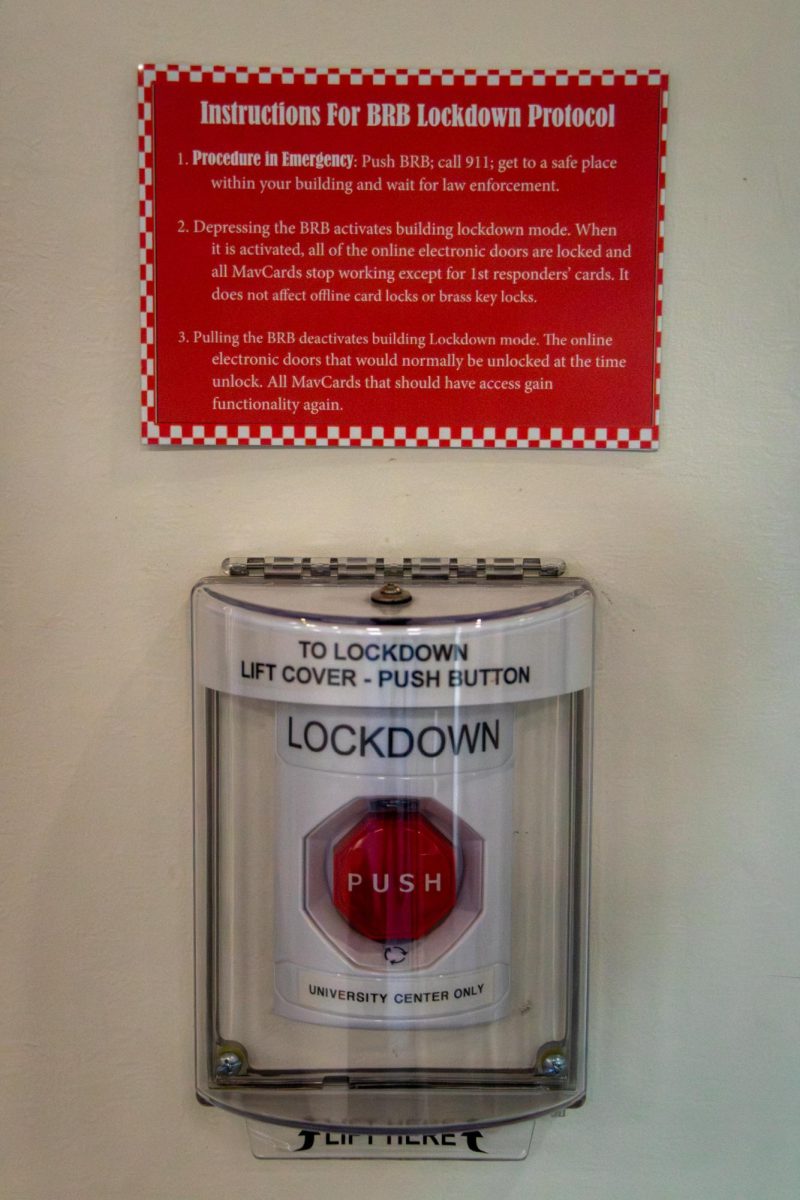
Marigold Nugent
The University Center (UC) has a big red button (BRB) behind its help desk that building occupants can press to lock the UC’s entrances in emergency situations. CMU is using recently granted state funding to add a mass notification system to pair with BRBs in all campus facilities.
Campus Safety recently tested its emergency notification system with a series of text messages and emails sent to students across campus on Oct. 3. CMU is continuing to expand towards other emergency safety measures with the installation of a new mass notification system (MNS).
CMU received $1,869,809 in funding for this project after Governor Jared Polis signed the 2025-2026 Long Appropriations Bill on May 24, 2025. This announcement system intends to work alongside the Big Red Buttons (BRB) across campus.
Currently, when pressed, a BRB will remotely lock all doors within an individual campus facility. MAVcard access to enter the building is also disabled, but students within the buildings can still exit. No one outside the facility can enter without the usage of a physical brass key. University officials are primarily responsible for determining when BRB usage is appropriate.
When a dangerous situation arises, building occupants do not receive notice of a BRB activation. Additionally, CMU lacks a standardized notification system to address why a lock down is occurring.
According to the 2018 and 2021 versions of the International Fire Code (IFC), college campuses and university buildings should have ways of communicating lock downs with building occupants. University buildings that may contain over 1,000 occupants must also perform a risk analysis to determine the necessity of a MNS installation.
Following a risk analysis conducted by CMU, a fire engineer working for the university determined all university facilities must include a MNS to mitigate communication issues. An identified failure in emergency situations is classified as a lack of standardized notice to building occupants about threats in an area.
Upon activation, a MNS will include a prerecorded message from a digital voice and audible sounds from a speaker strobe. CMU opted for a speaker strobe instead of a horn strobe, as the latter evokes a traditional fire alarm system.
Access Technologies and Life Safety (ATLaS) believes this new system will more accurately and readily notify students of emergencies.
“With the addition of the Mass Notification System, we believe it will change safety dynamics on campus through rapid communication and response for students, staff, faculty and visitors,” Manager of ATLaS Horacio Salazar said. “This will keep them informed from a distance as soon as an emergency has been identified.”
Kent Marsh, the Vice President for Capital Planning, Sustainability and Campus Operations, submitted the proposal request as a part of the 2025-2026 Long Appropriations Bill in May 2024. Once approved, the addition of a MNS became a requirement for all future campus construction. Currently, the Asteria Theatre includes a MNS and BRB.
CMU divided the new MNS installation into two phases, with the first consisting of retrofitting seven buildings that are currently incompatible with MNS technology. These buildings include Tomlinson Library, Confluence Hall, Dominguez Hall, Escalante Hall, the Kephart Fine Arts building, the health sciences building and Houston Hall.
Additionally, the Student Wellness Center and Grand Junction Police Department (GJPD) near campus will receive a local operating control (LOC) station. The Student Services Office in Lowell Heiny Hall will also receive a LOC for its university officials.
During emergencies, these LOCs will allow for campuswide mass notification. Each system will also include a microphone for custom mass notification messages. University officials and students can issue these messages to a single building, a group of buildings or all buildings connected to the MNS.
“Students will have access to the Mass Notification with the prerecorded MNS messages and a microphone to broadcast timely emergency messages throughout each building,” Salazar said.
The second phase of installation will include buildings from CMU’s main campus, CMU Tech and CMU Montrose. For the main campus, these facilities include Wubben Science Hall, Lowell Heiny Hall, the Student Wellness Center, Albers Hall, Rotary Hall, the Admissions building, campus service buildings and the Maverick Center.
CMU Tech’s installations will take place in the Archuleta Engineering Center and its laboratory, Kayenta Hall, Youngblood Hall, Chinle Hall and campus service buildings. CMU Montrose will receive a MNS in its respective campus service buildings.
Jaime Cox, the capital projects manager for CMU, will lead all installation efforts.
As of now, CMU has not hired a design team for the MNS installation project, and the associated construction and design contracts remain unawarded. To use the Colorado state funding, there is a hiring timeline CMU must meet.
“. . .CMU [must] hire a design team on or before November 1, 2025 [or] all funds [will] be fully encumbered on or before May 2028,” Marsh said. “However, the design team will begin work over the next three or four weeks and ought to have construction drawings complete for three of [the] four of the buildings included in the first phase project in early spring.”
Marsh estimates contracts should be awarded by spring 2026 and construction will likely begin in May 2026. Completion of the MNS installation project is suspected to fall before the fall 2026 semester.
Student leaders are looking forward to the first phase of CMU’s newest safety measure.
“I believe that our university administration truly has our best interests at heart. When it comes to student safety, they don’t play,” Associated Student Government (ASG) president Lelani Domingo said. “I am over the moon excited for this new messaging system. I think it is going to save a lot of our students.”